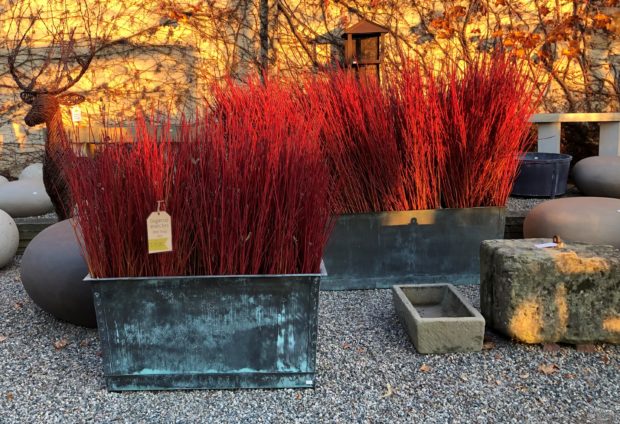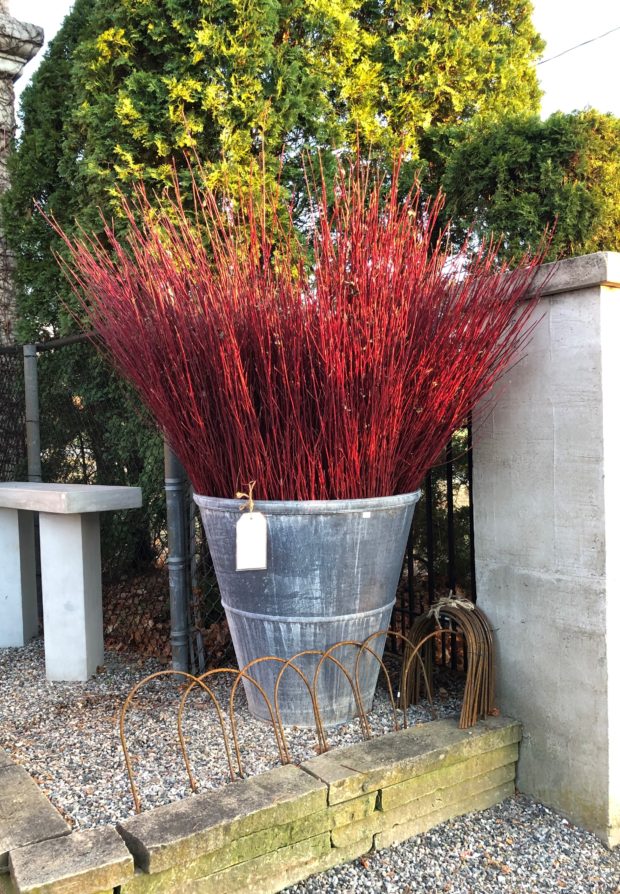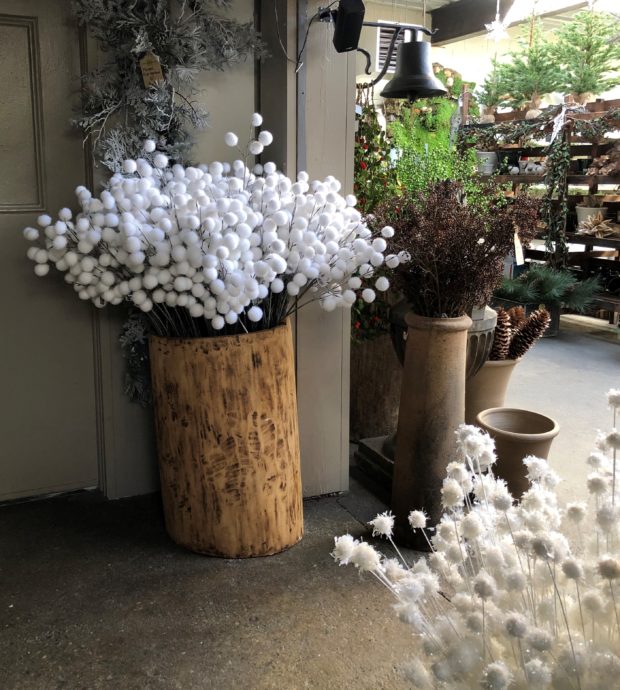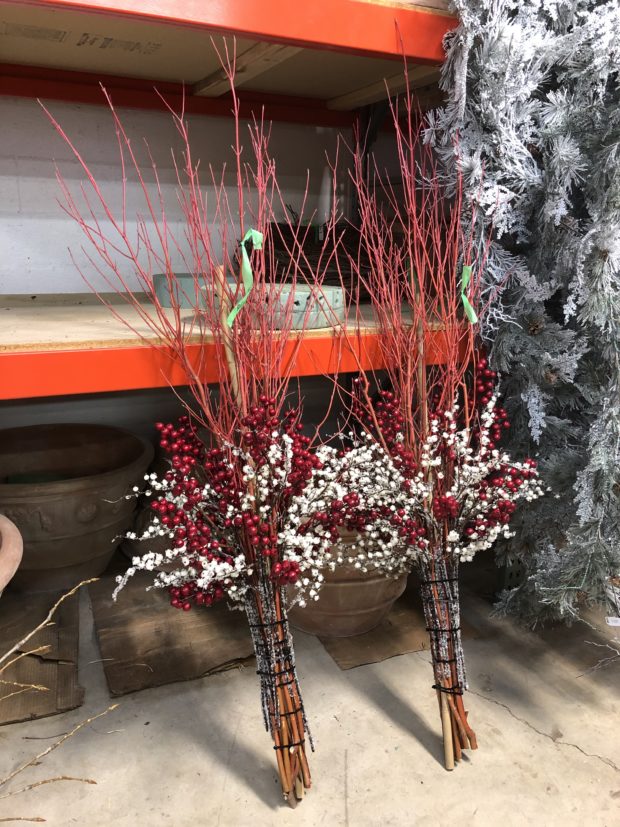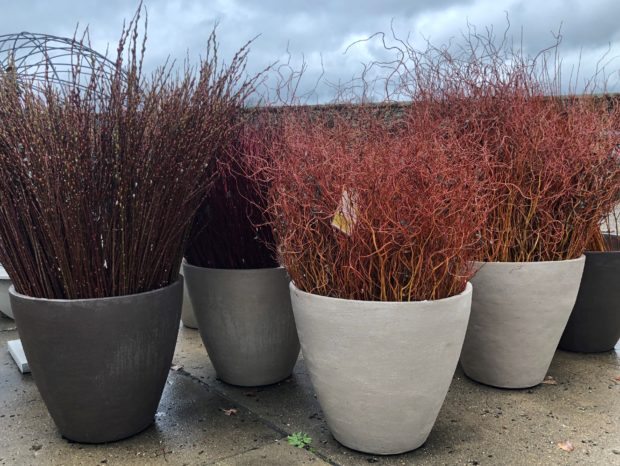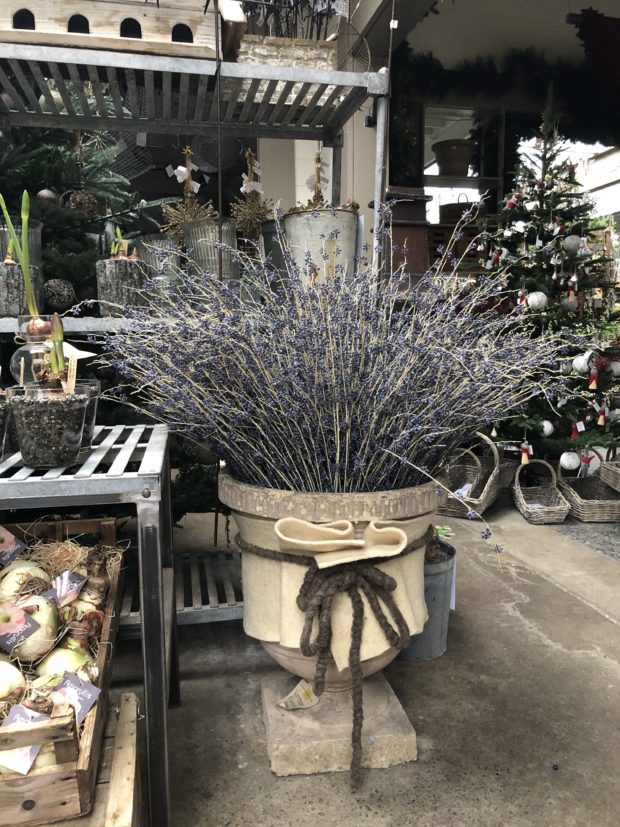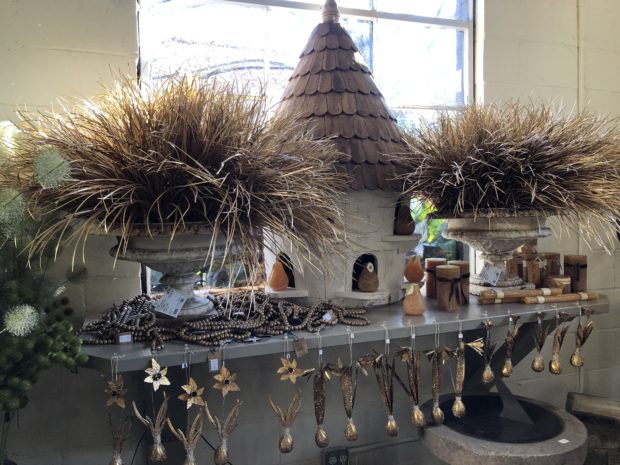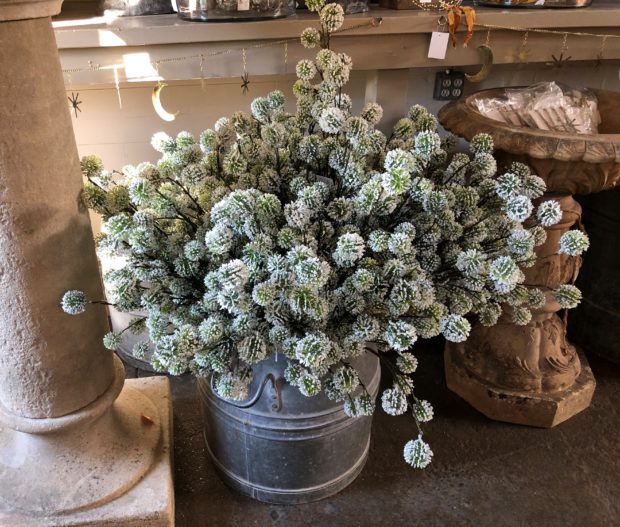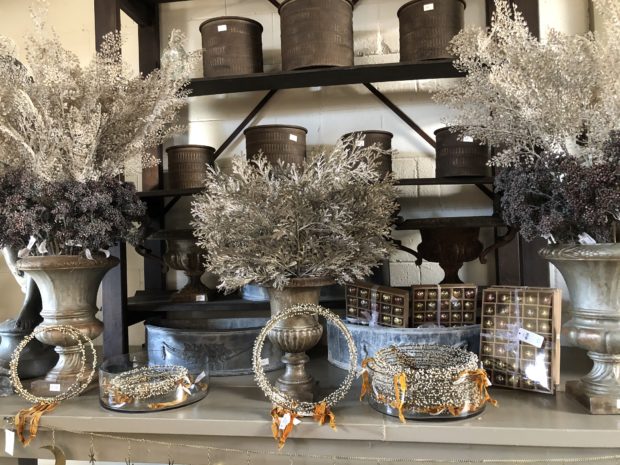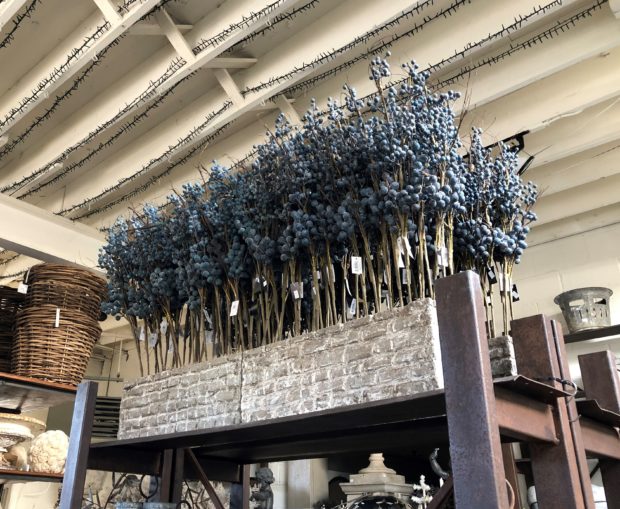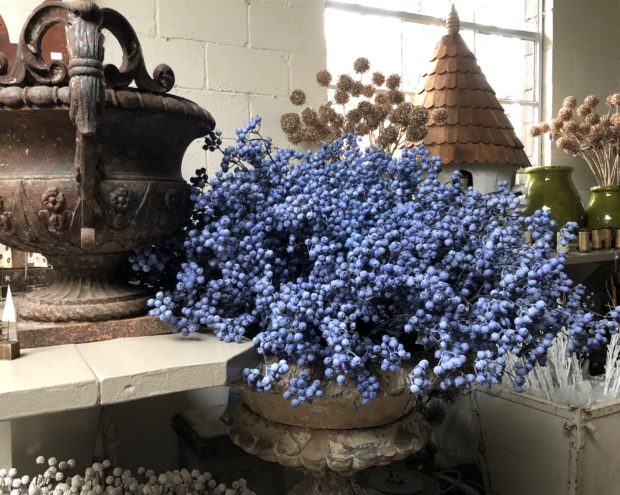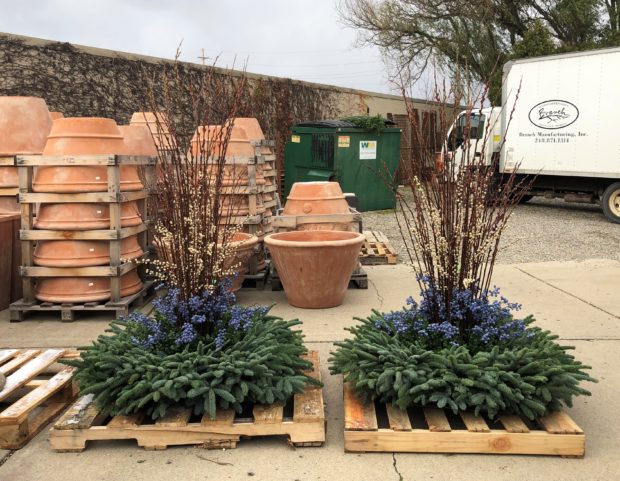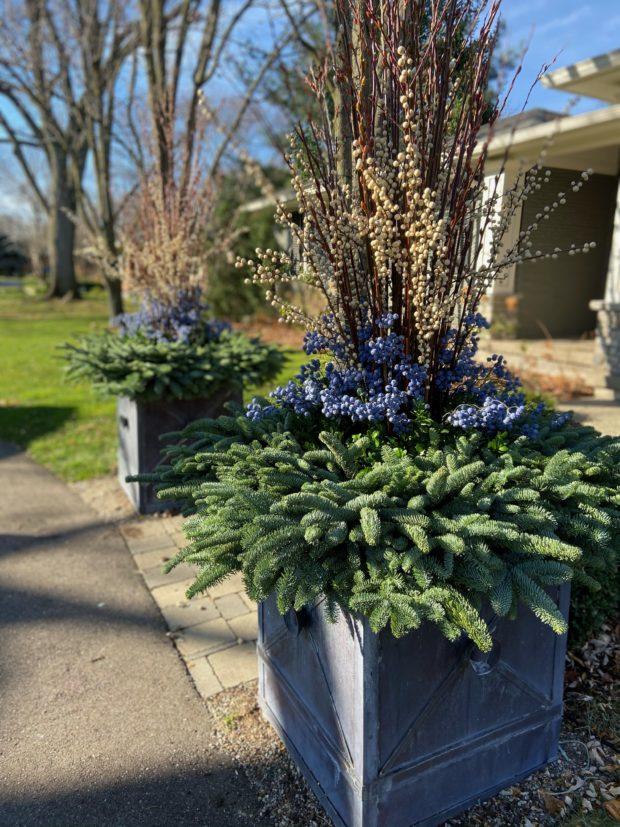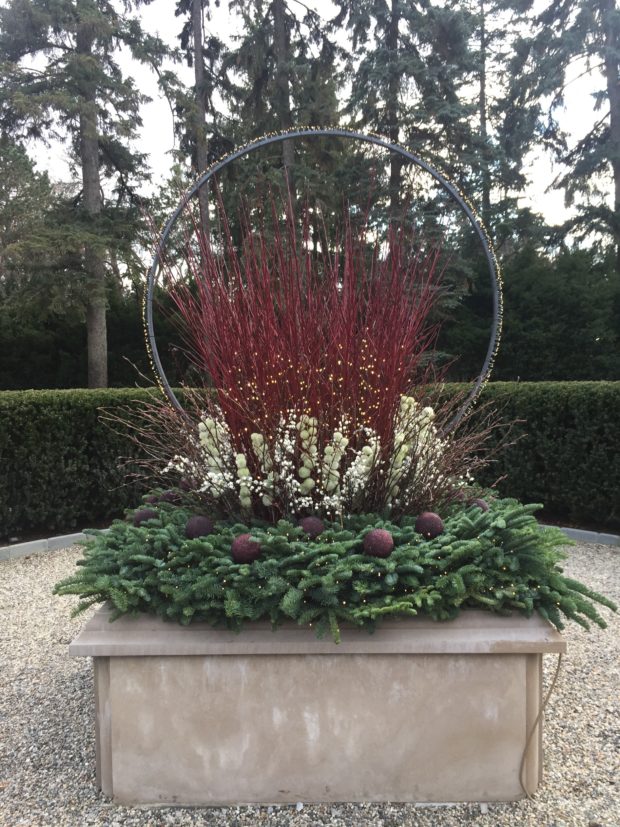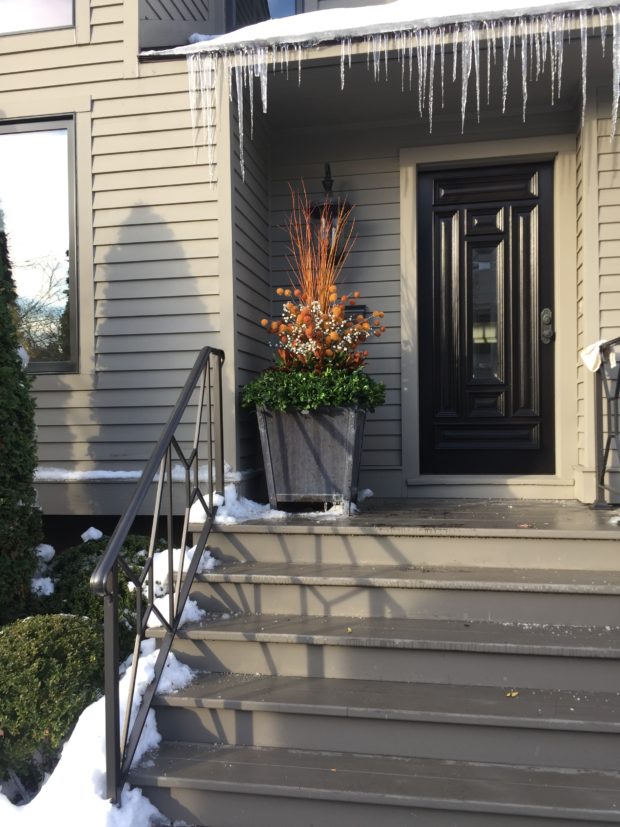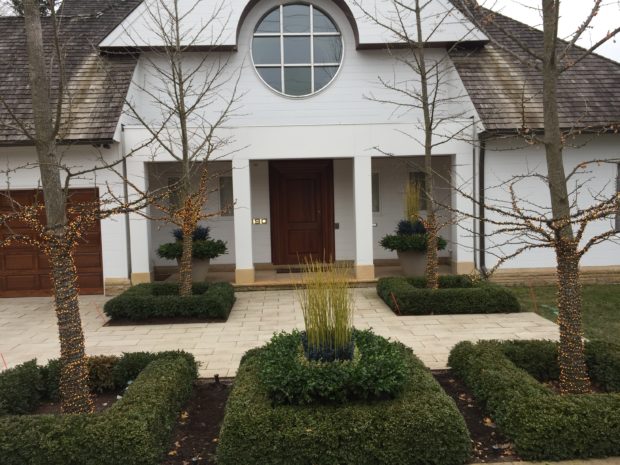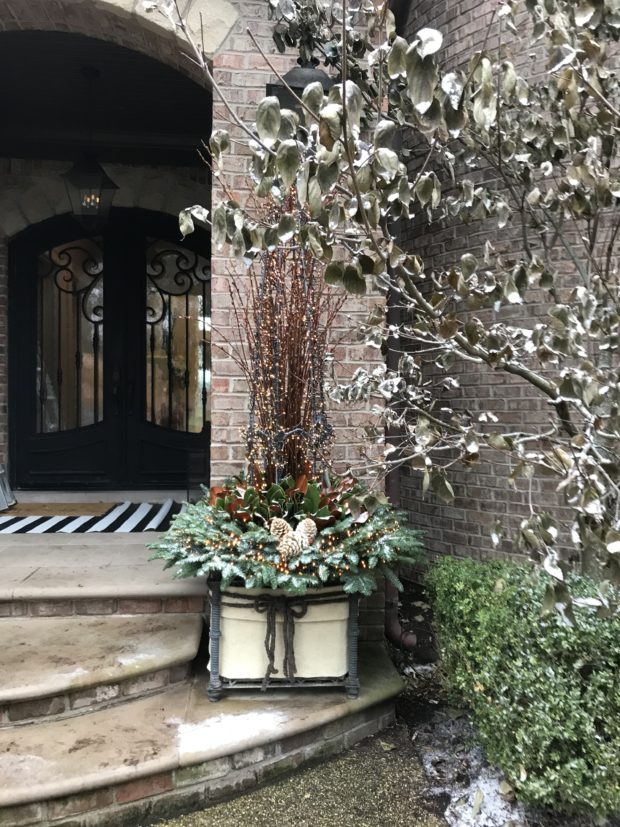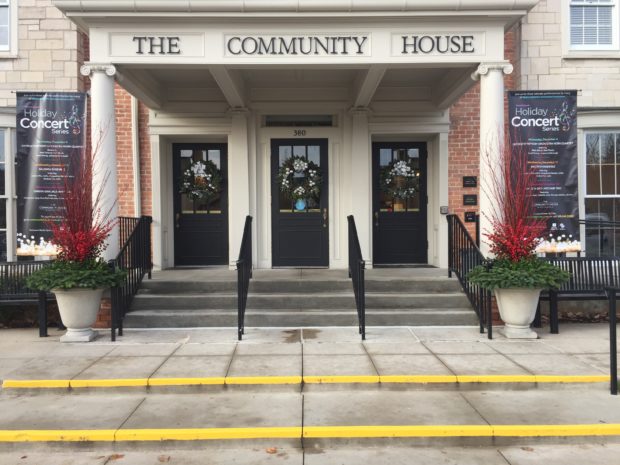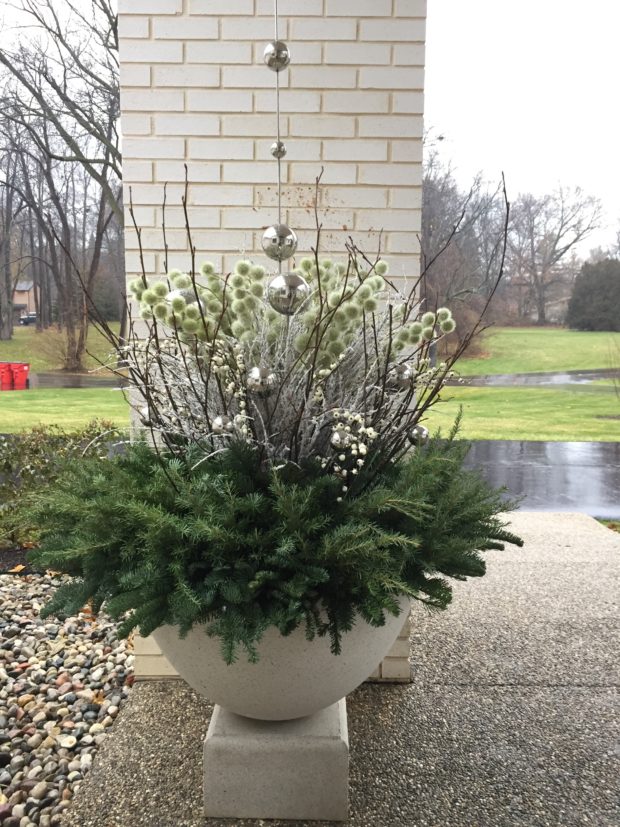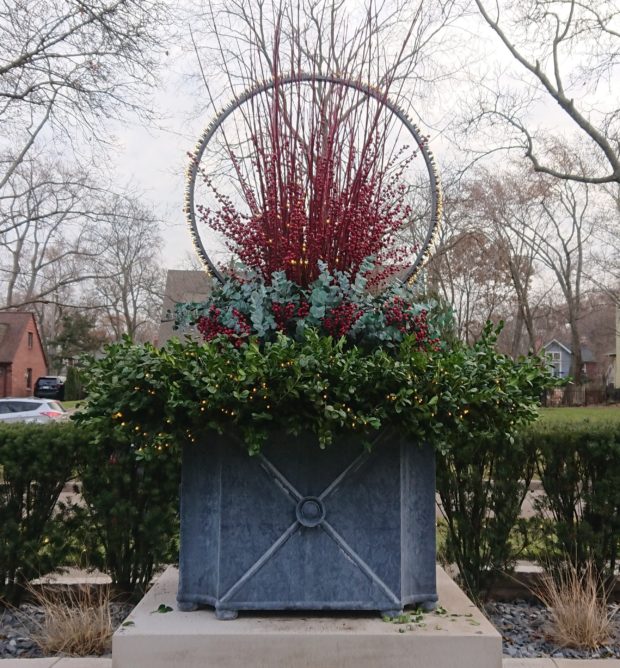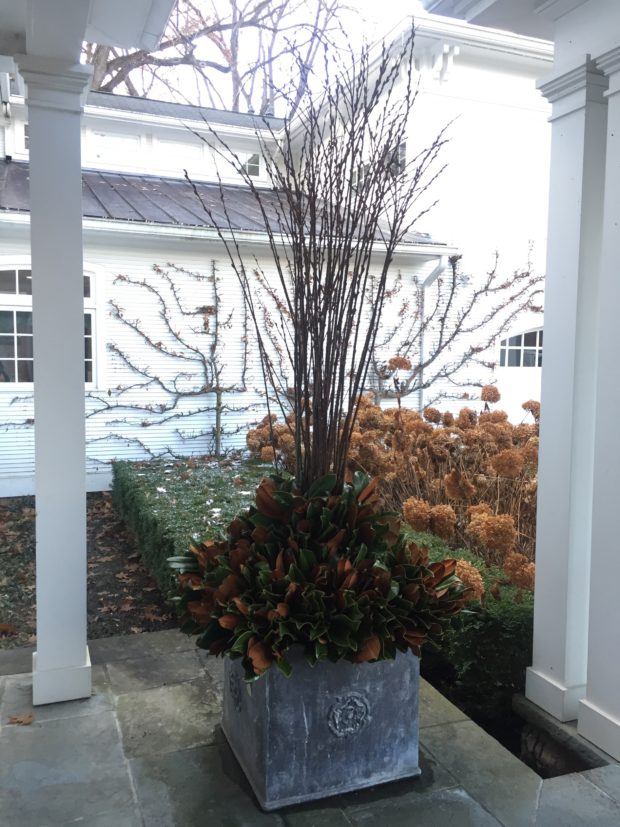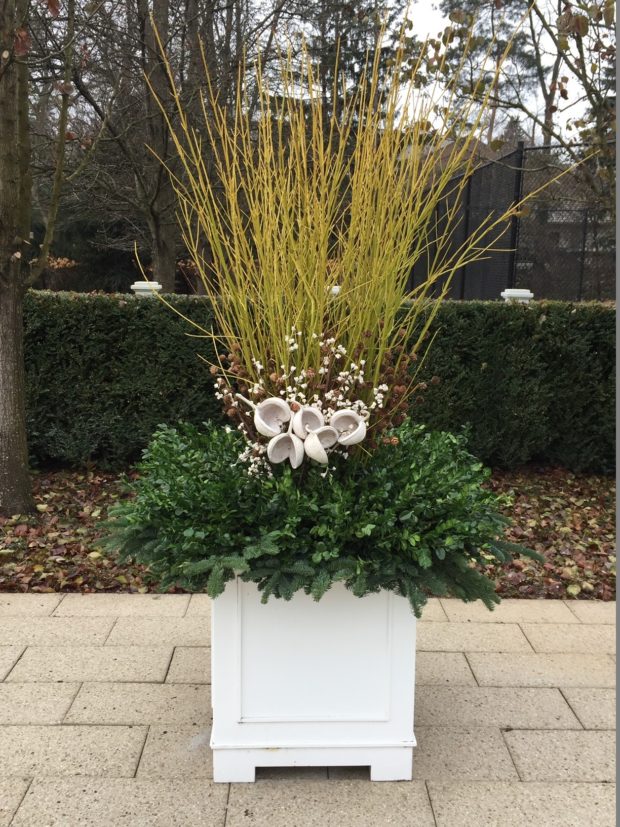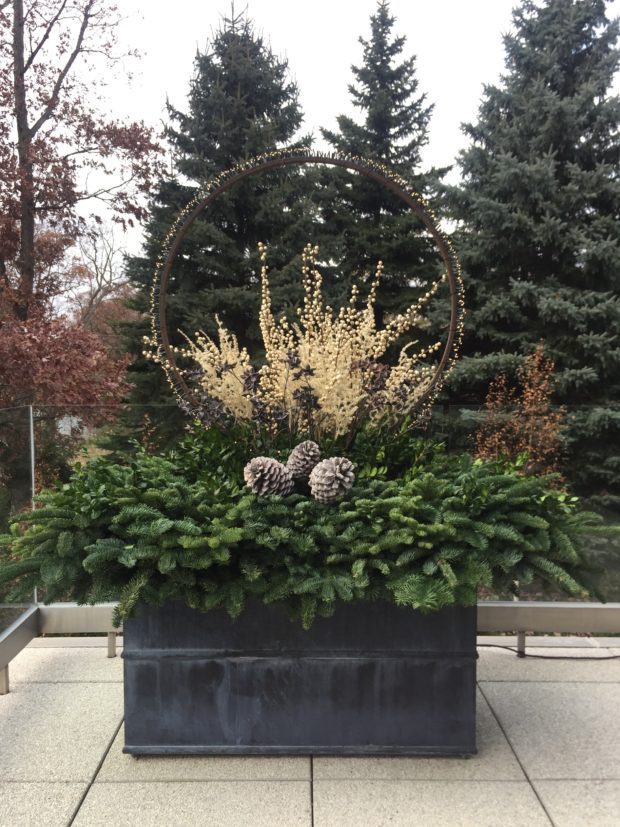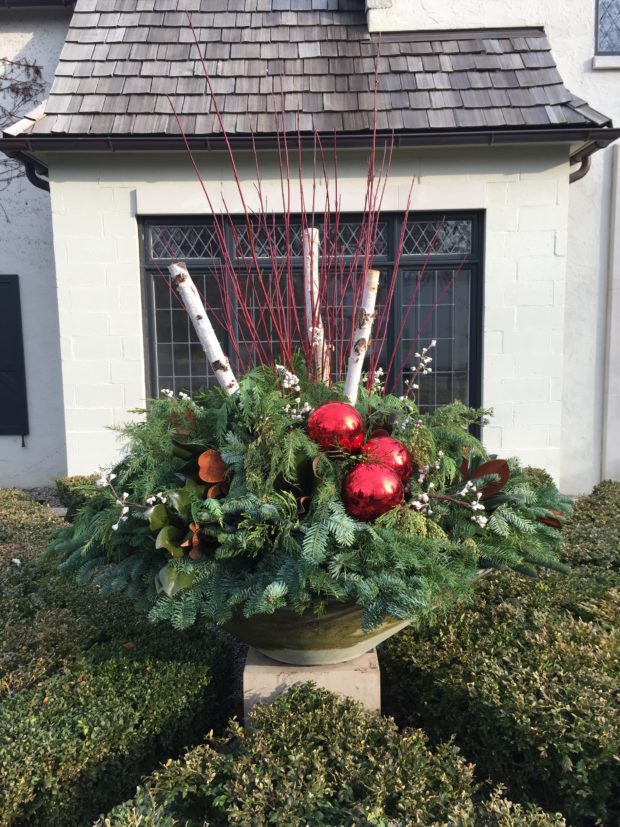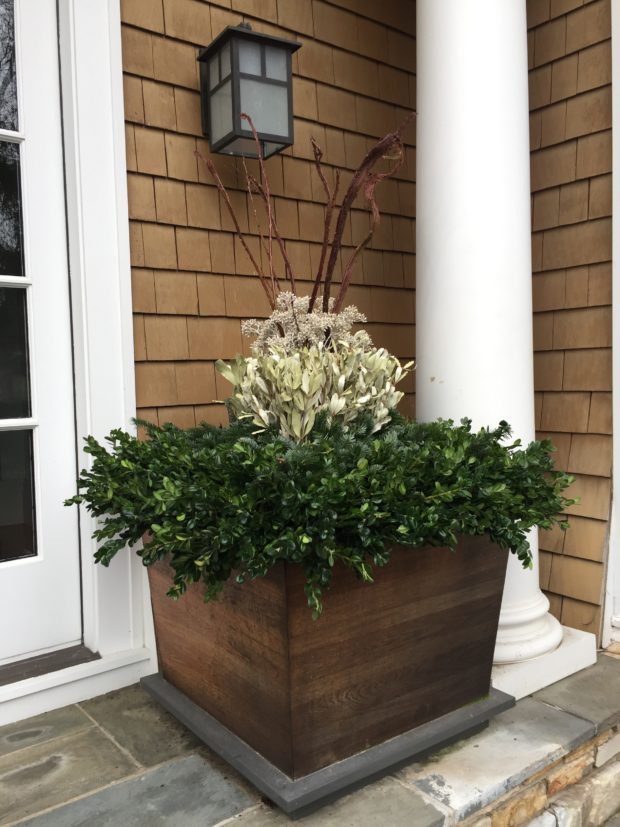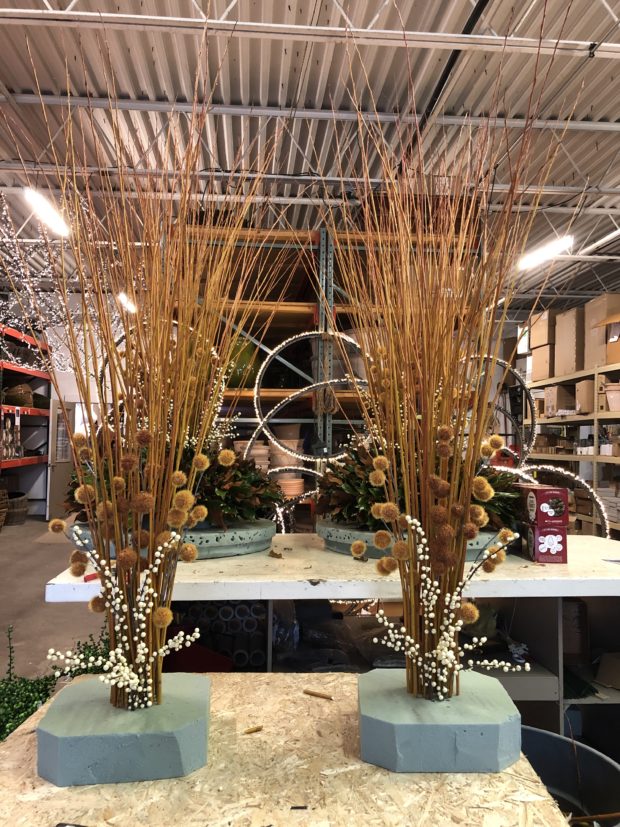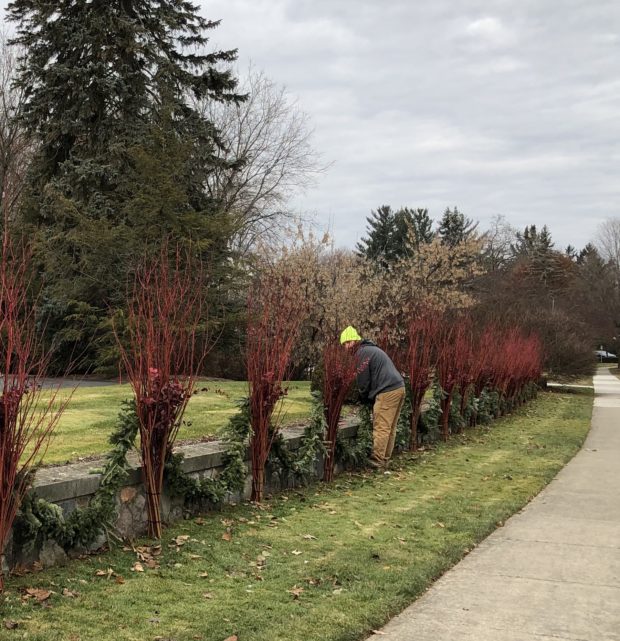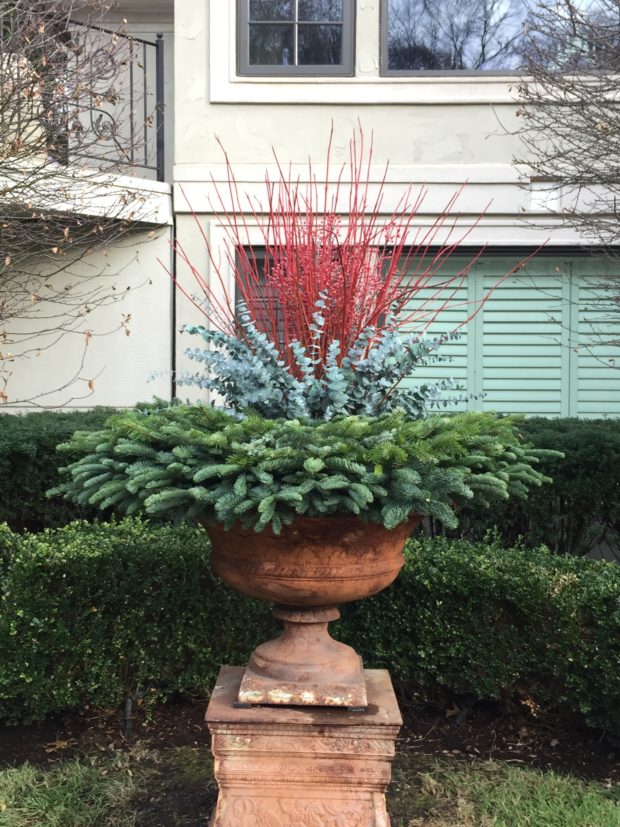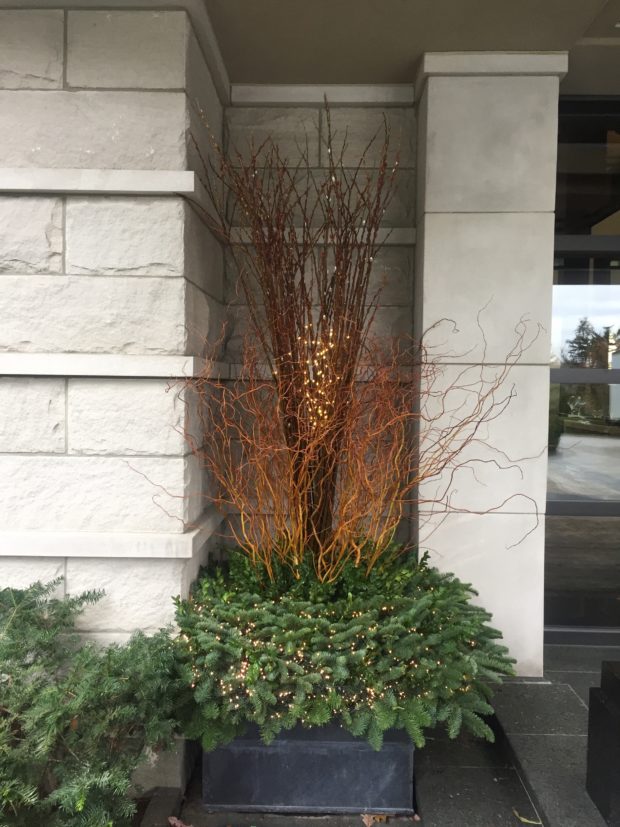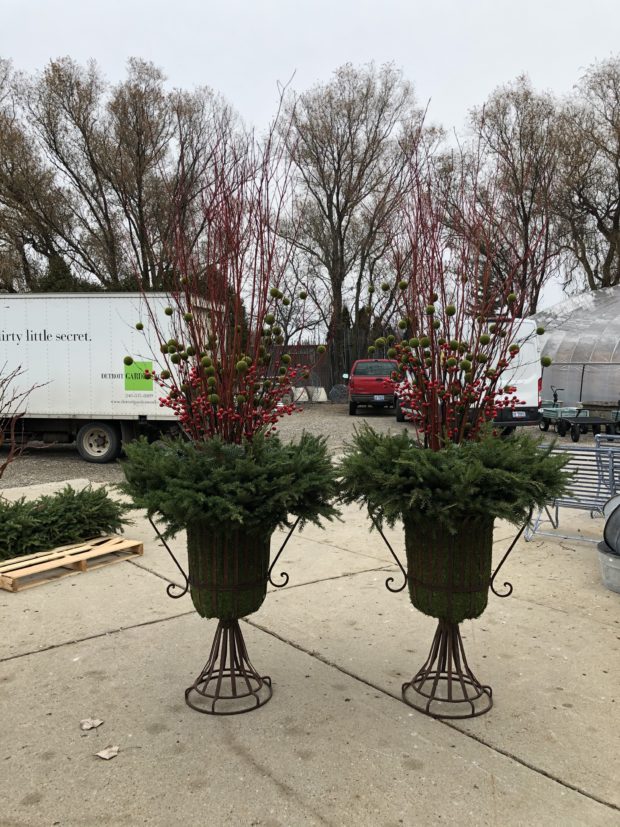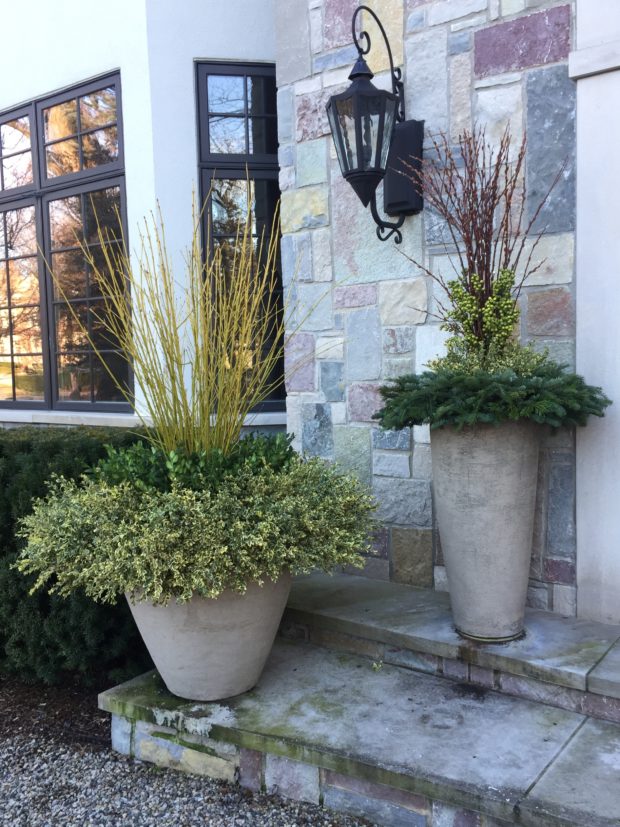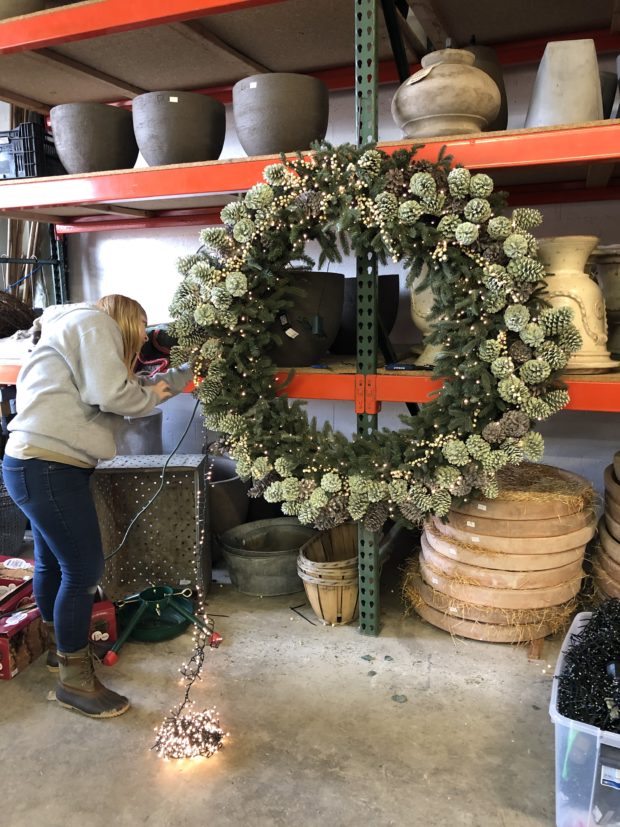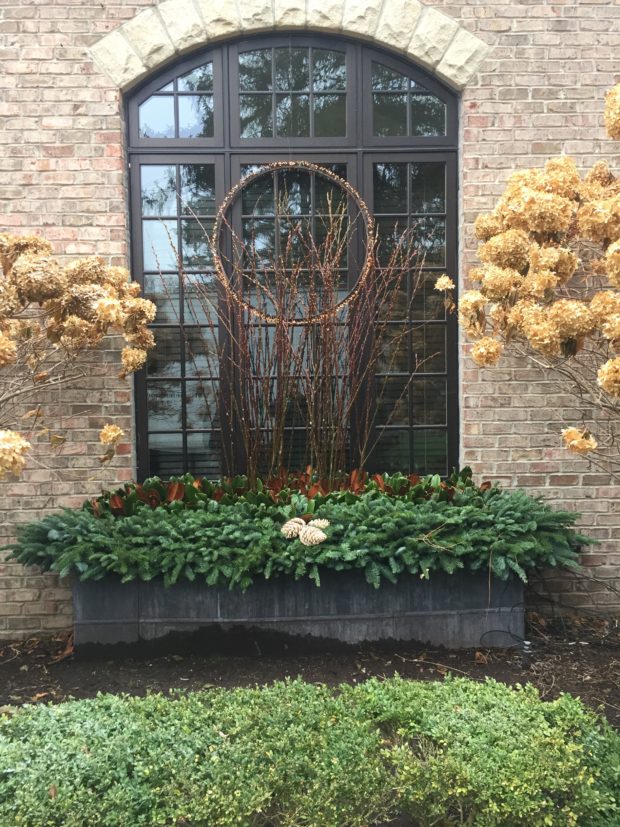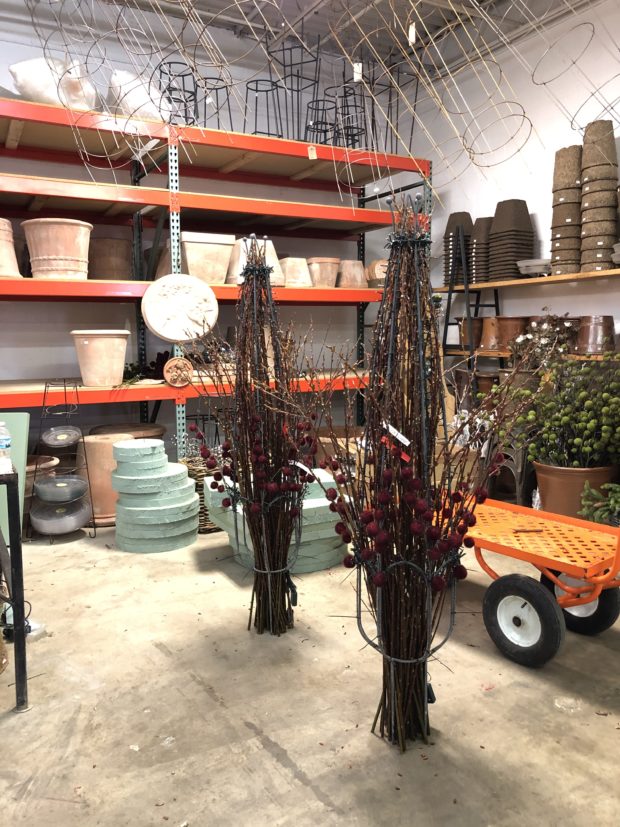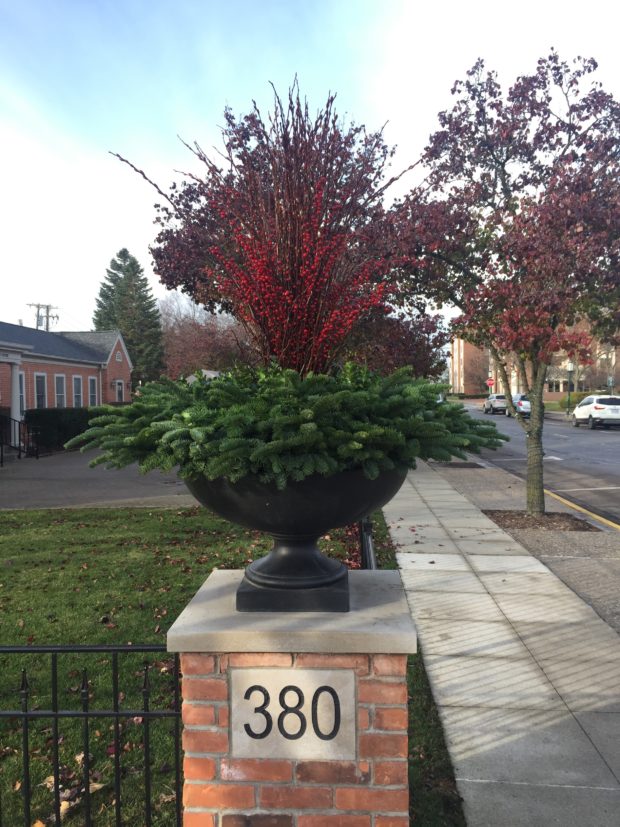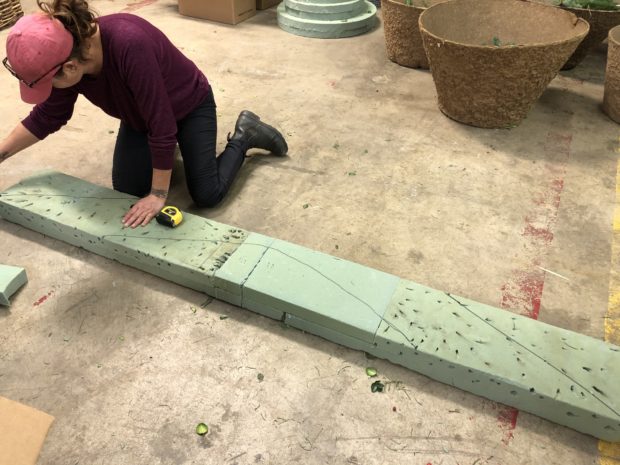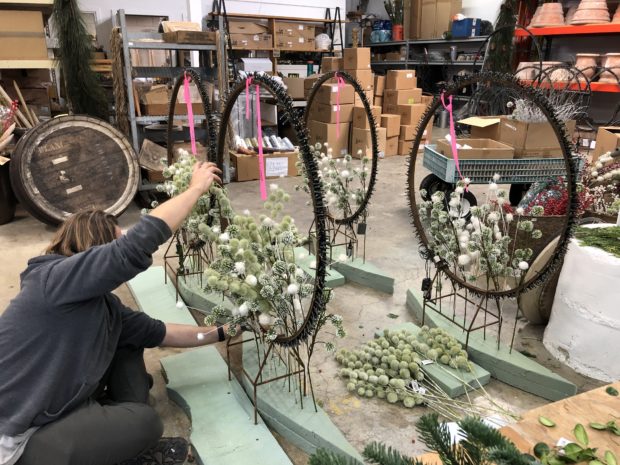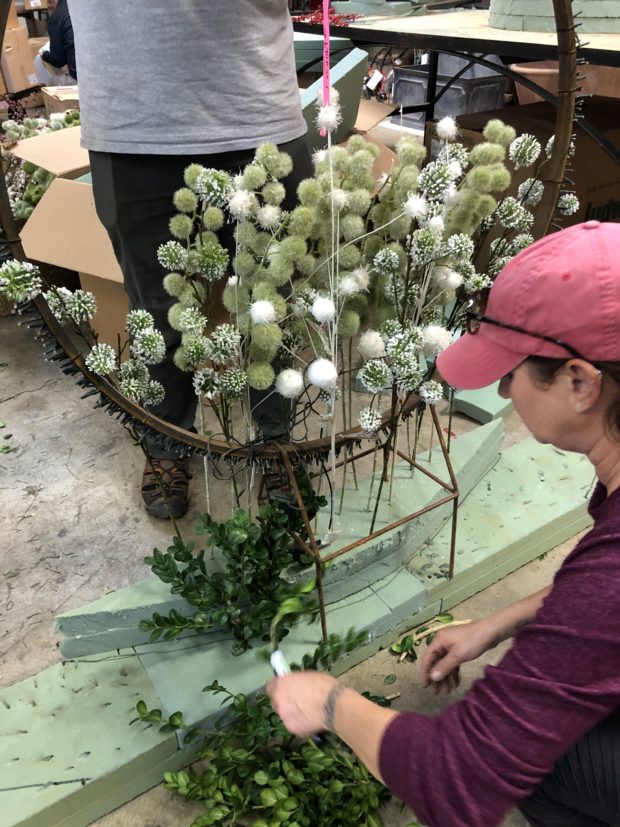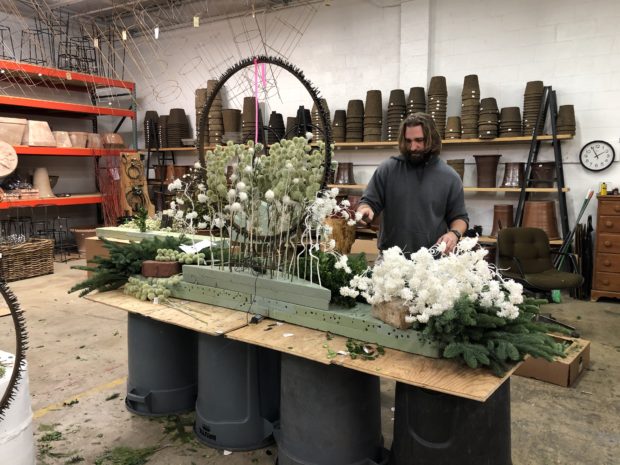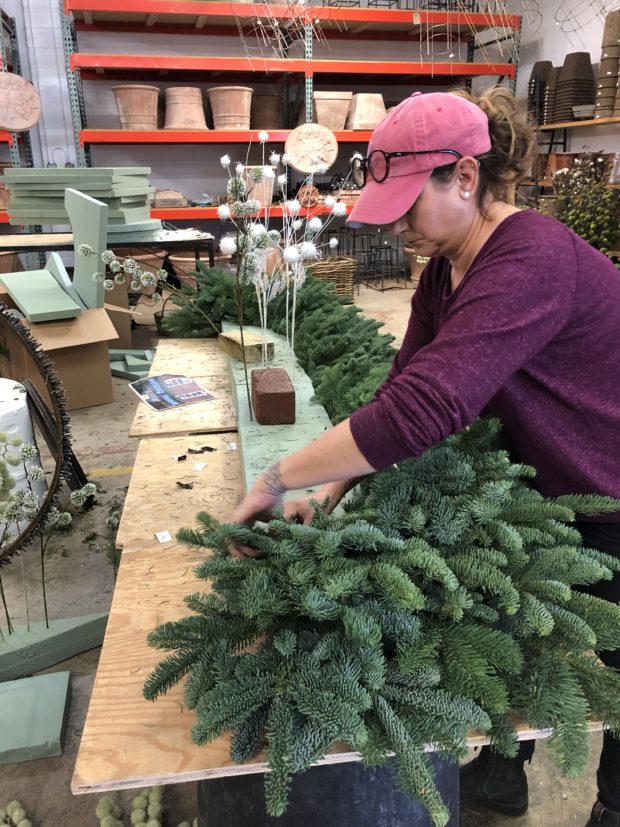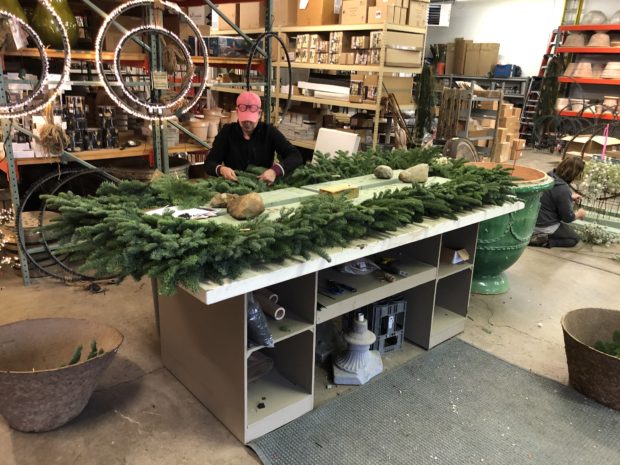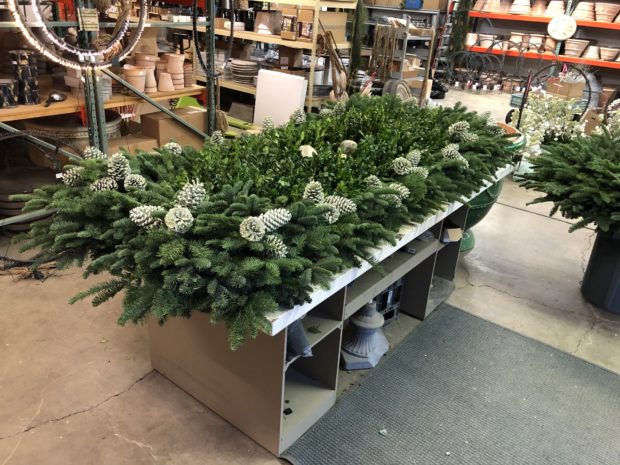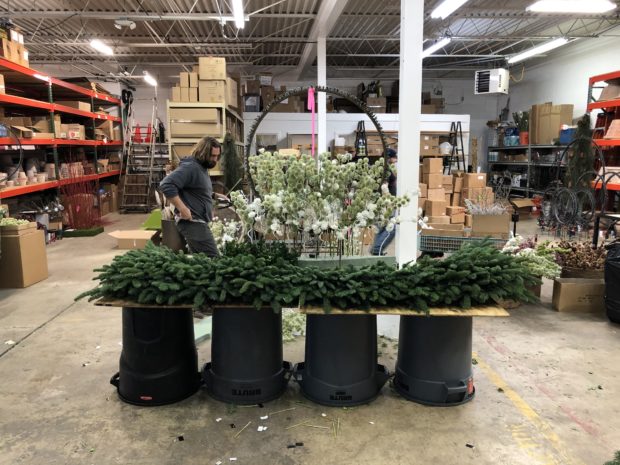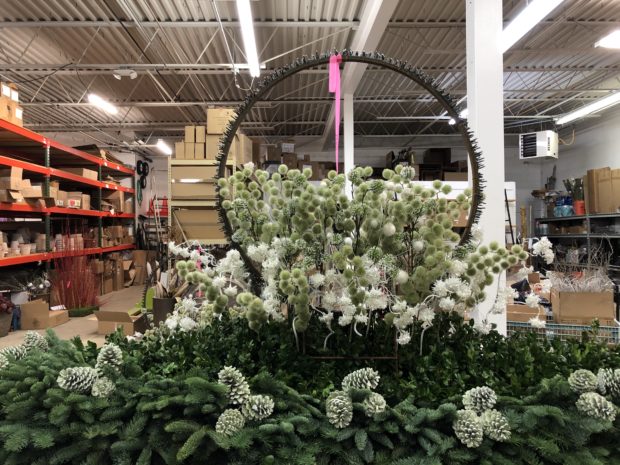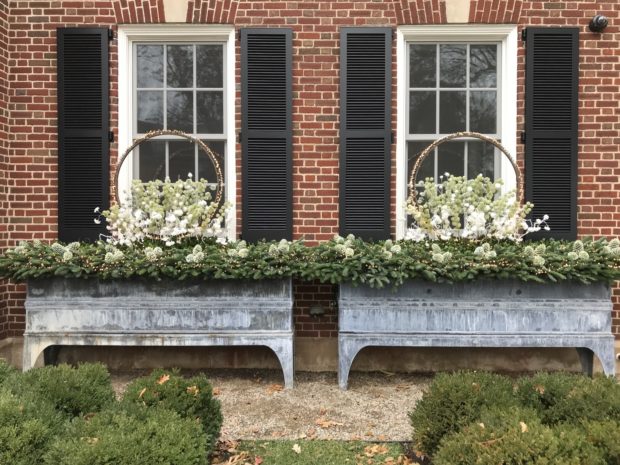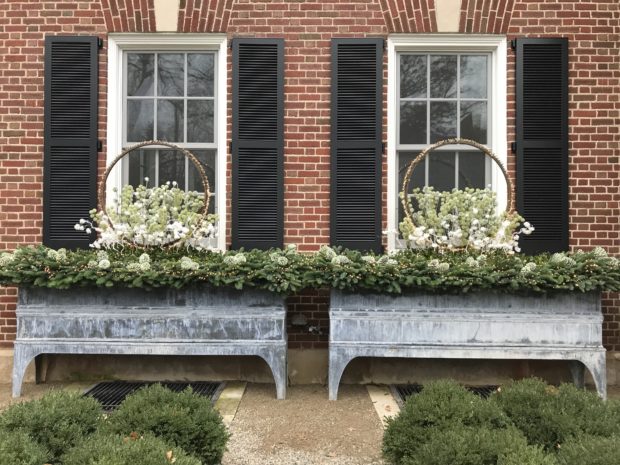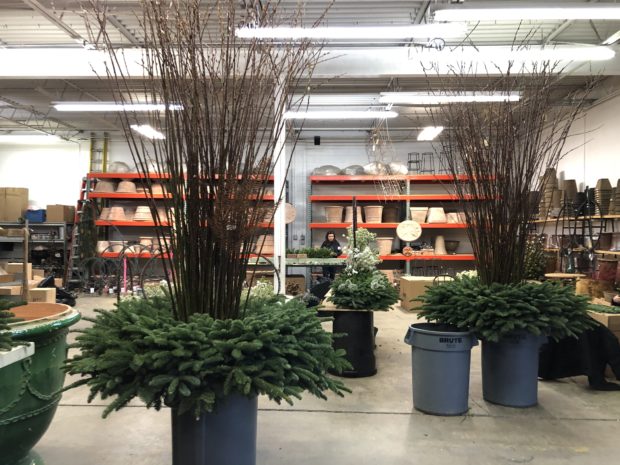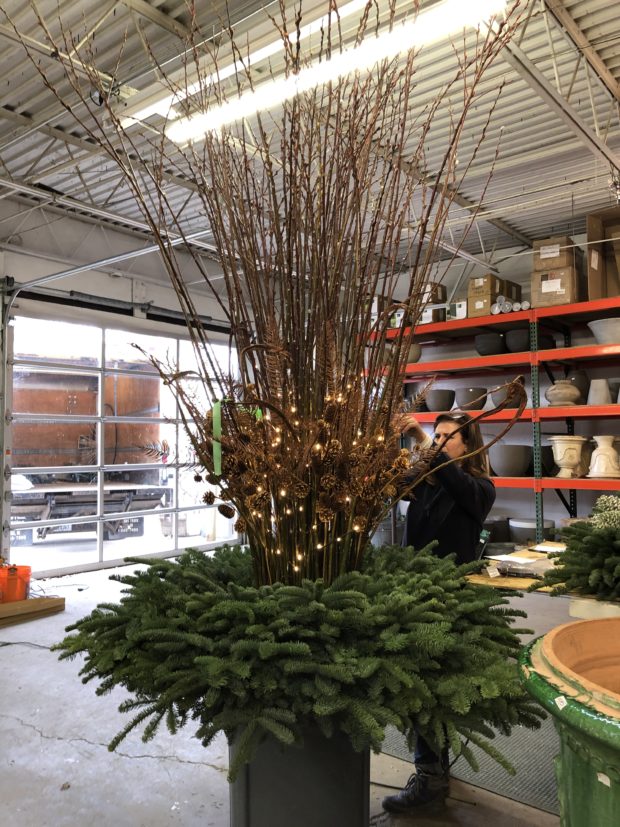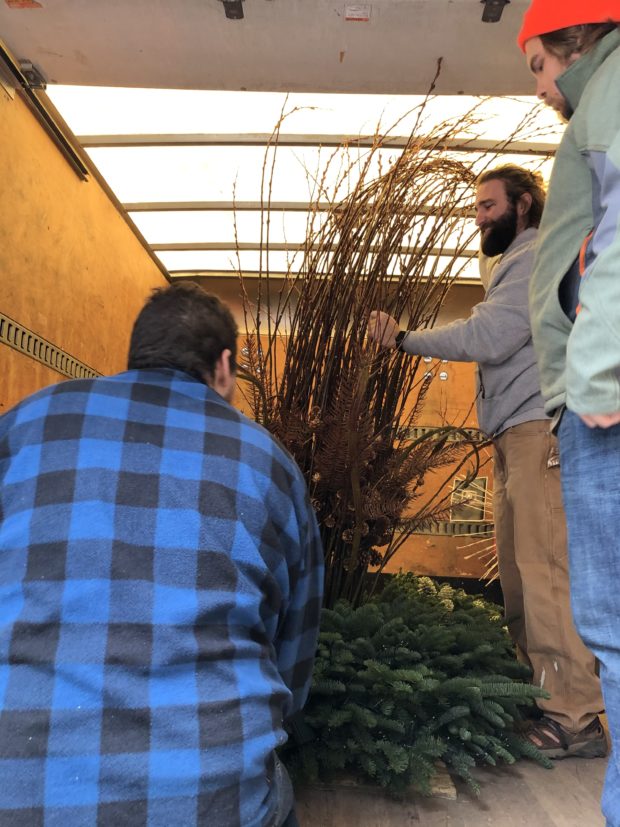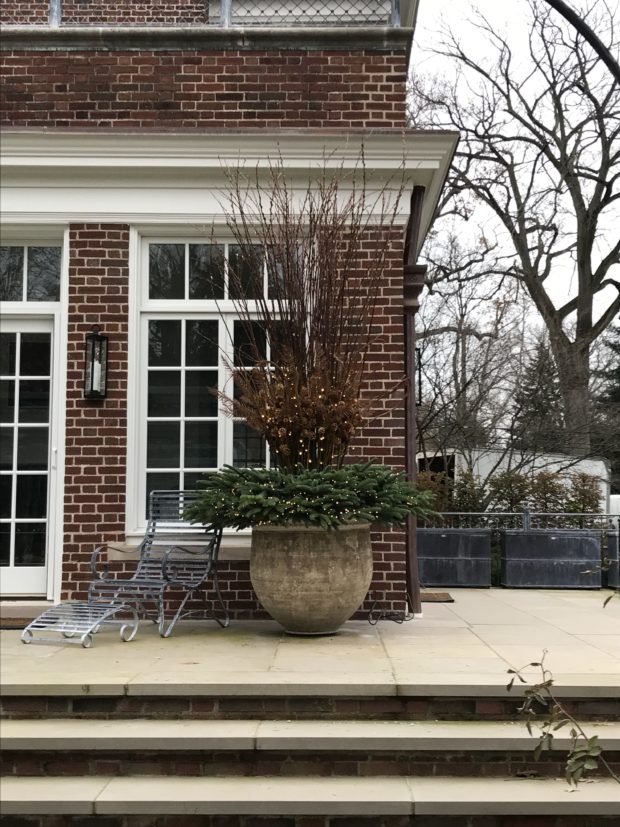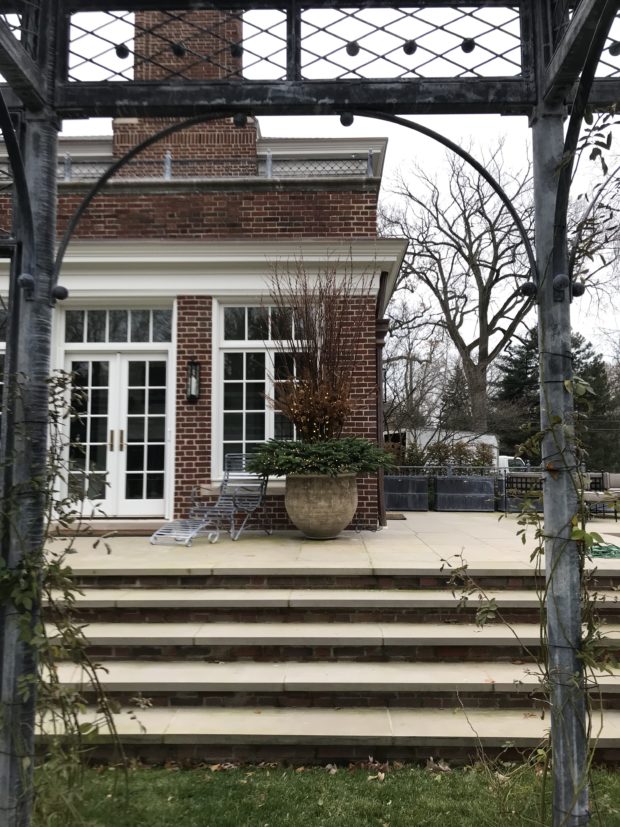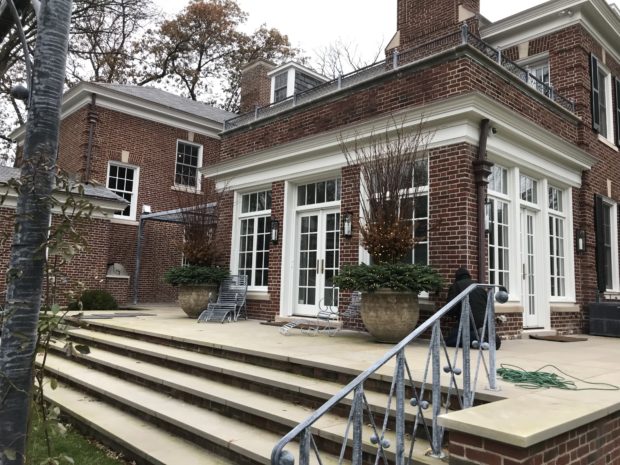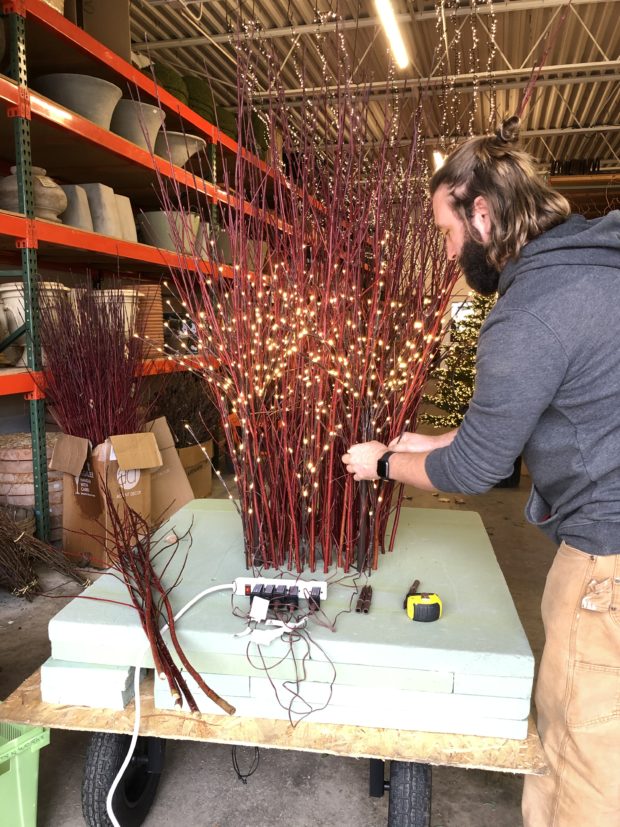 Every winter container project presents its own unique set of challenges. Those challenges may relate to location, armature construction, materials or design. But getting the scale and proportion right is always the most difficult. A winter arrangement that is under scaled relative to the size of the intended container will always look out of proportion, no matter the beauty of the design and materials. Part of the remedy is keeping the size and location of your intended arrangement in mind during the fabrication process.
Every winter container project presents its own unique set of challenges. Those challenges may relate to location, armature construction, materials or design. But getting the scale and proportion right is always the most difficult. A winter arrangement that is under scaled relative to the size of the intended container will always look out of proportion, no matter the beauty of the design and materials. Part of the remedy is keeping the size and location of your intended arrangement in mind during the fabrication process.
 As alluded to before, we do not construct our arrangements on site any more. Transporting materials to a job site involves a lot of packing up and unpacking. And a trip back to the shop if you are short of something you need. The materials you didn’t need have to be repacked for the trip home. Working in a cold environment slows the work down, and makes concentration on the work difficult. Sweeping up debris from a cold surface is usually unsatisfactory. But the ease of fabricating in a studio comes with a down side – getting the scale and proportion right. A collection of photographs of the container and the location, as well as experience, play a key role in getting an arrangement to proper scale. The above two pictures were taken the first year we did this project.
As alluded to before, we do not construct our arrangements on site any more. Transporting materials to a job site involves a lot of packing up and unpacking. And a trip back to the shop if you are short of something you need. The materials you didn’t need have to be repacked for the trip home. Working in a cold environment slows the work down, and makes concentration on the work difficult. Sweeping up debris from a cold surface is usually unsatisfactory. But the ease of fabricating in a studio comes with a down side – getting the scale and proportion right. A collection of photographs of the container and the location, as well as experience, play a key role in getting an arrangement to proper scale. The above two pictures were taken the first year we did this project.
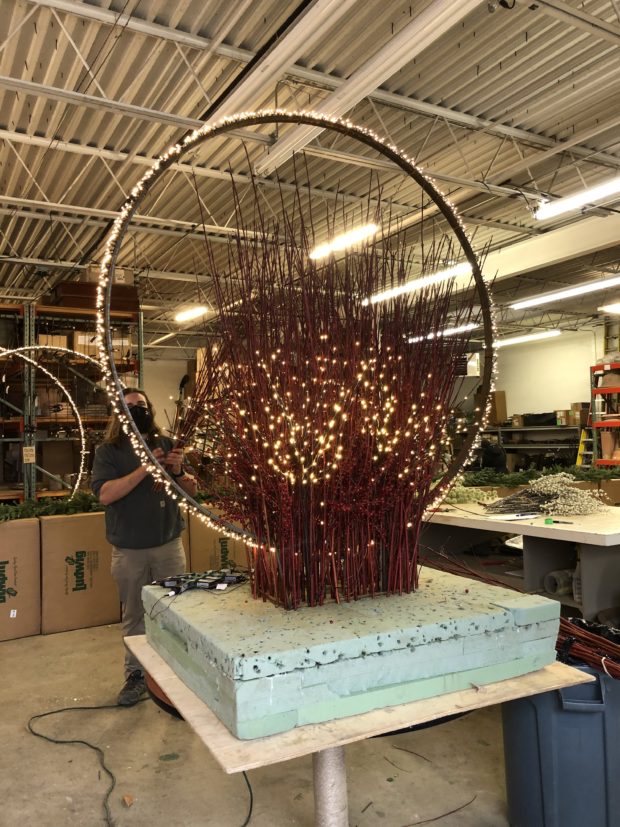 The arrangement will be placed in a fountain that is central to a fairly large formal garden. The focal point is a steel light ring that is 5 feet in diameter. The ring, designed and manufactured by Detroit Garden Works, is welded to a steel base with four long rod steel legs. All of the construction would be done in a dry floral foam armature which fits snugly into the fountain basin. The lower four inches of the dry floral foam form will sit below the rim of the fountain. The upper four inches provides a stable receptacle for all of the materials-including the legs of the light ring. Not seen in this picture is a large hole in the center of the form that allows for the fountain jet which sits up above the rim of the basin. This form allows all of the materials to be inserted at the maker’s discretion. At whatever angle or density they like. It permits the greens to be arranged in a more believable and natural formation. There is only one way to stick greens into a container of soil, and that is up and down, or on a slight angle. The form permits for sideways or strongly angled placements. The dry foam is forgiving of a maker who needs to stick a branch three times before finding just the right spot for it.
The arrangement will be placed in a fountain that is central to a fairly large formal garden. The focal point is a steel light ring that is 5 feet in diameter. The ring, designed and manufactured by Detroit Garden Works, is welded to a steel base with four long rod steel legs. All of the construction would be done in a dry floral foam armature which fits snugly into the fountain basin. The lower four inches of the dry floral foam form will sit below the rim of the fountain. The upper four inches provides a stable receptacle for all of the materials-including the legs of the light ring. Not seen in this picture is a large hole in the center of the form that allows for the fountain jet which sits up above the rim of the basin. This form allows all of the materials to be inserted at the maker’s discretion. At whatever angle or density they like. It permits the greens to be arranged in a more believable and natural formation. There is only one way to stick greens into a container of soil, and that is up and down, or on a slight angle. The form permits for sideways or strongly angled placements. The dry foam is forgiving of a maker who needs to stick a branch three times before finding just the right spot for it.
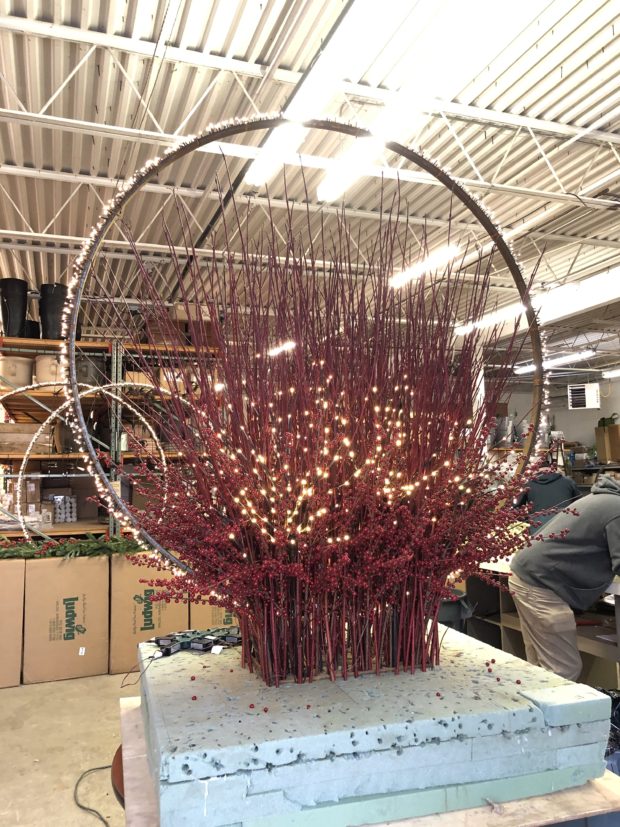 Dry floral foam was traditionally used in the construction of silk and dry arrangements for the home. Unlike oasis, which is a single use water absorptive mechanism for temporarily holding cut flowers, dry foam forms can be used a number of years in a winter container, provided careful handling. It does not absorb any water. A form with a tight fit acts as a waterproof lid on the container during the winter season. The cut greens and twigs will retain their color throughout the winter without any water. Rain in January will be shed, rather than given entry into the pot. We reuse forms over a number of years, as repairing them is simple. We only use premium grade and length cut evergreen branches, which means several things. It does not take as many to create a lush look, as each branch is lush in and of itself. A long length of boughs coming out of the form permits a size that is appropriate to the scale set by the container. We also remove the needles at the bottom of each bough, and sharpen them. This insures a tight fit, and makes as small a hole as possible in the form.
Dry floral foam was traditionally used in the construction of silk and dry arrangements for the home. Unlike oasis, which is a single use water absorptive mechanism for temporarily holding cut flowers, dry foam forms can be used a number of years in a winter container, provided careful handling. It does not absorb any water. A form with a tight fit acts as a waterproof lid on the container during the winter season. The cut greens and twigs will retain their color throughout the winter without any water. Rain in January will be shed, rather than given entry into the pot. We reuse forms over a number of years, as repairing them is simple. We only use premium grade and length cut evergreen branches, which means several things. It does not take as many to create a lush look, as each branch is lush in and of itself. A long length of boughs coming out of the form permits a size that is appropriate to the scale set by the container. We also remove the needles at the bottom of each bough, and sharpen them. This insures a tight fit, and makes as small a hole as possible in the form.
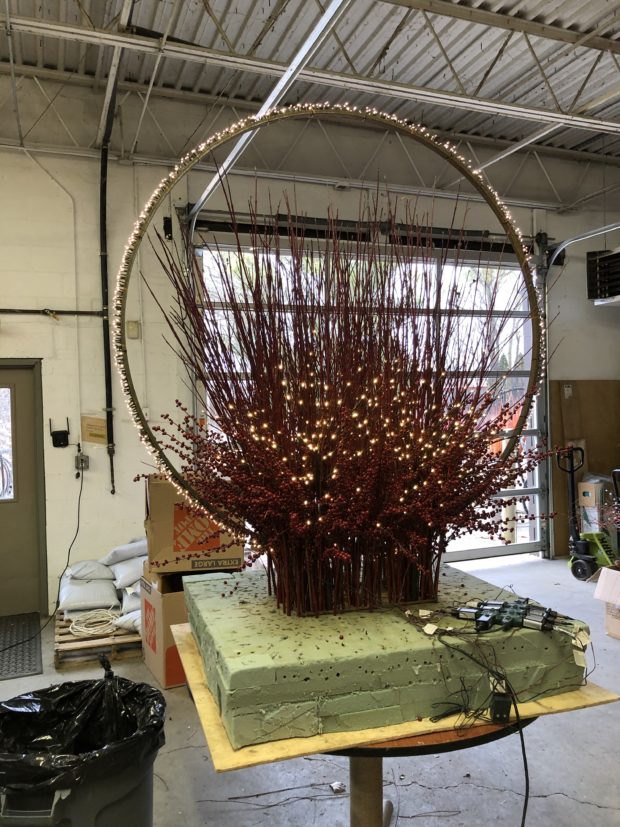 A large arrangement that is liberally stuffed with twigs will be saturated in color, but the look at night may go dark. Rob has made a specialty of twiggy light apparatus that can be a virtually invisible part of those natural twigs. This helps to convey the color and form of those twigs in the dark hours-of which we have many. The light ring will create an aura all around that centerpiece at night in a dramatic and welcome way. The worst of the winter is the darkness.
A large arrangement that is liberally stuffed with twigs will be saturated in color, but the look at night may go dark. Rob has made a specialty of twiggy light apparatus that can be a virtually invisible part of those natural twigs. This helps to convey the color and form of those twigs in the dark hours-of which we have many. The light ring will create an aura all around that centerpiece at night in a dramatic and welcome way. The worst of the winter is the darkness.
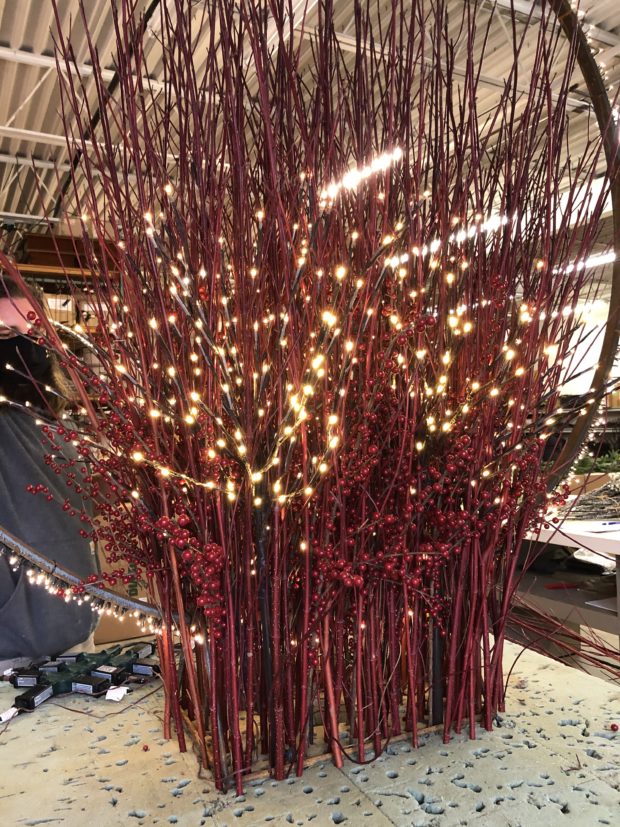 Farmed red twig dogwood features smooth glossy bark, unmarred by injury or twig dieback. This is a byproduct of a single year’s growth on the stems. Older stems from a red twig dogwood shrub loose color and luster. This new growth is red twig dogwood in its most brilliant coloration. In order to emphasize that dark wine red color, we added faux berry stems of a matching color. It is hard to get the color red to read in the winter landscape unless there is a lot of it. A large container arrangement suffers if there is too little material, or material that is too small. The berry stems are a different form than the vertical red twig, a different texture, and present a different shape. But that mass of color will read as red over a great distance.
Farmed red twig dogwood features smooth glossy bark, unmarred by injury or twig dieback. This is a byproduct of a single year’s growth on the stems. Older stems from a red twig dogwood shrub loose color and luster. This new growth is red twig dogwood in its most brilliant coloration. In order to emphasize that dark wine red color, we added faux berry stems of a matching color. It is hard to get the color red to read in the winter landscape unless there is a lot of it. A large container arrangement suffers if there is too little material, or material that is too small. The berry stems are a different form than the vertical red twig, a different texture, and present a different shape. But that mass of color will read as red over a great distance.
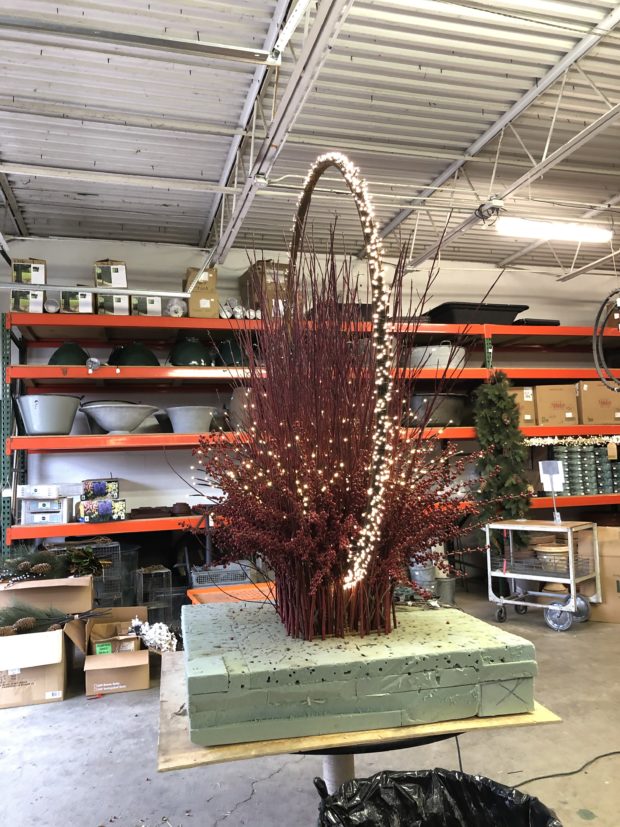 We do work with the lighting on, so the placement of the light is as even as possible. The contrast of the mass of lights on the ring to the dots of lights in the twigs will add another dimension to the visual impact of the arrangement.
We do work with the lighting on, so the placement of the light is as even as possible. The contrast of the mass of lights on the ring to the dots of lights in the twigs will add another dimension to the visual impact of the arrangement.
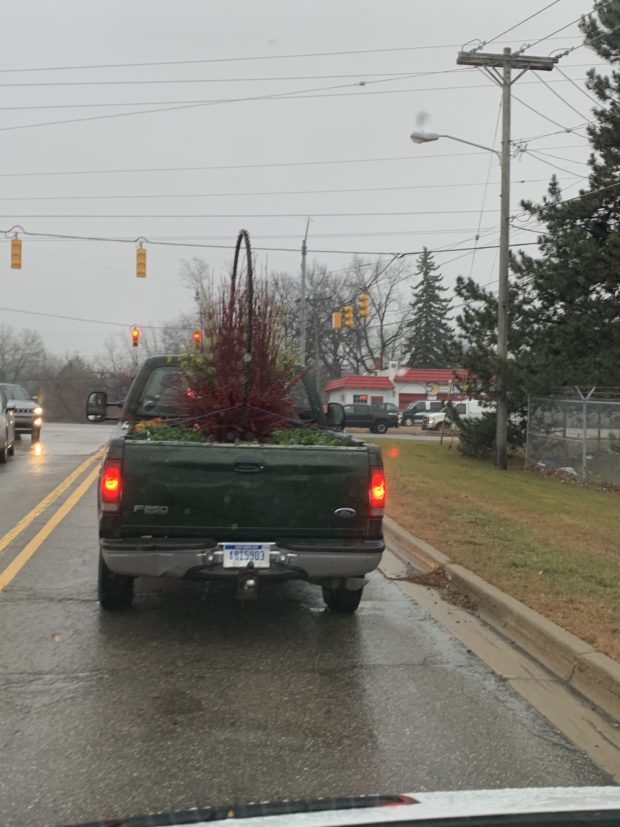 The transport to the site required a pick up truck, as the light ring was too tall for a box truck. A gloomy drizzly day illustrates how dark red is all the darker and less red in the absence of bright light. The arrangement had a large thin piece of plywood slipped underneath it, to prevent the form from cracking or breaking. Providing all over support to the form is essential to keeping it in one piece. No one wants to make repairs at this stage.
The transport to the site required a pick up truck, as the light ring was too tall for a box truck. A gloomy drizzly day illustrates how dark red is all the darker and less red in the absence of bright light. The arrangement had a large thin piece of plywood slipped underneath it, to prevent the form from cracking or breaking. Providing all over support to the form is essential to keeping it in one piece. No one wants to make repairs at this stage.
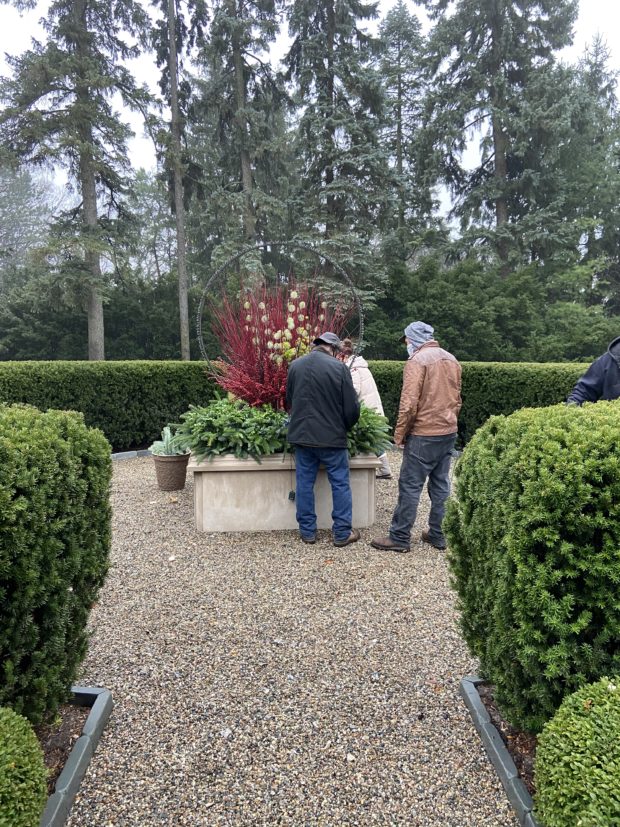 It took four people to lift the arrangement, and set it in the fountain. The crew splits up after this moment. One group handles all of the electrical hookups, and one handles the final finish. All of the cords will be shallowly buried in the gravel, and hidden in the existing shrubs. Any material that has been jarred out of place during transport will be put to right. It takes a number of skilled people to create and install an arrangement of this size, start to finish.
It took four people to lift the arrangement, and set it in the fountain. The crew splits up after this moment. One group handles all of the electrical hookups, and one handles the final finish. All of the cords will be shallowly buried in the gravel, and hidden in the existing shrubs. Any material that has been jarred out of place during transport will be put to right. It takes a number of skilled people to create and install an arrangement of this size, start to finish.
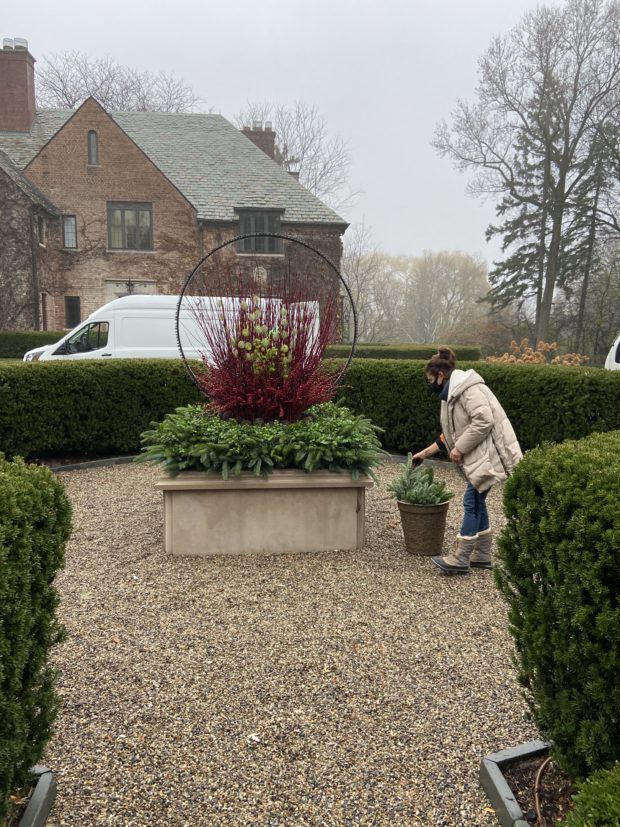 Once an arrangement is set in place, Birdie will know what spots need a tune up. She brings a tool kit, and plenty of cut greens.
Once an arrangement is set in place, Birdie will know what spots need a tune up. She brings a tool kit, and plenty of cut greens.
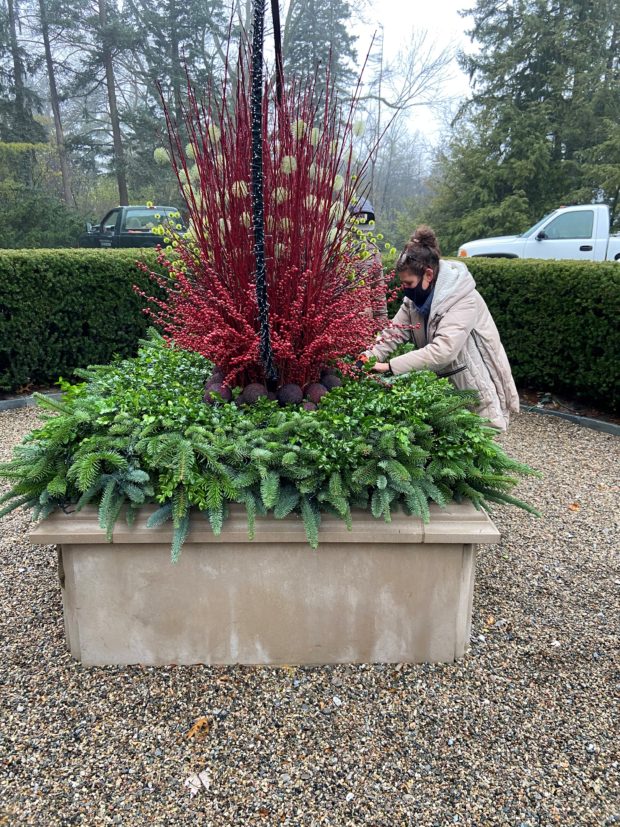 Part of what she does will include hiding the electrical mechanisms still inside the pot. At the base of the arrangement is a row of large wine red beaded balls on picks. She will reset those so they make a perfectly straight line around all four sides of the centerpiece.That very dark red at the base provides some lift and breathing room between the red centerpiece, and the greens. It also gives the impression that the centerpiece is floating.
Part of what she does will include hiding the electrical mechanisms still inside the pot. At the base of the arrangement is a row of large wine red beaded balls on picks. She will reset those so they make a perfectly straight line around all four sides of the centerpiece.That very dark red at the base provides some lift and breathing room between the red centerpiece, and the greens. It also gives the impression that the centerpiece is floating.
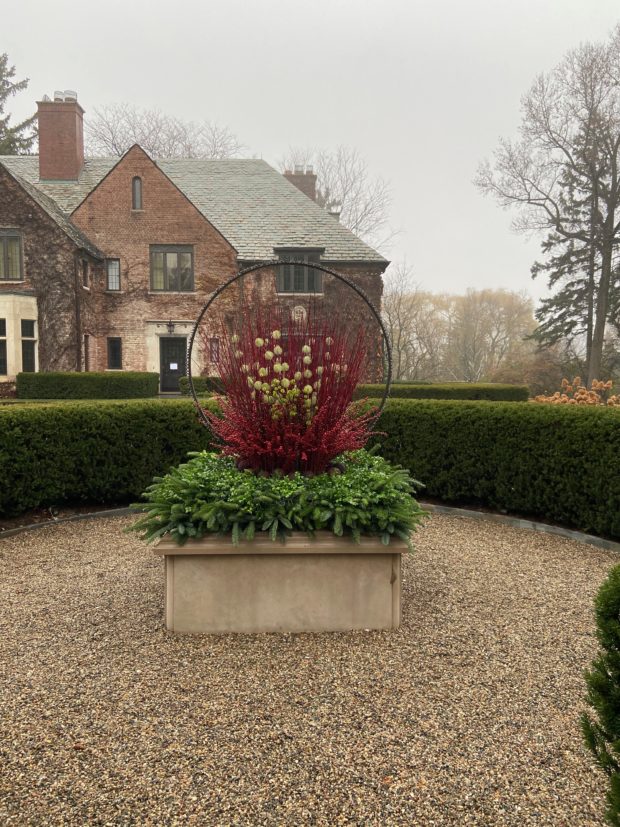 Just the thing – making a massive and weighty centerpiece appear to hover.
Just the thing – making a massive and weighty centerpiece appear to hover.
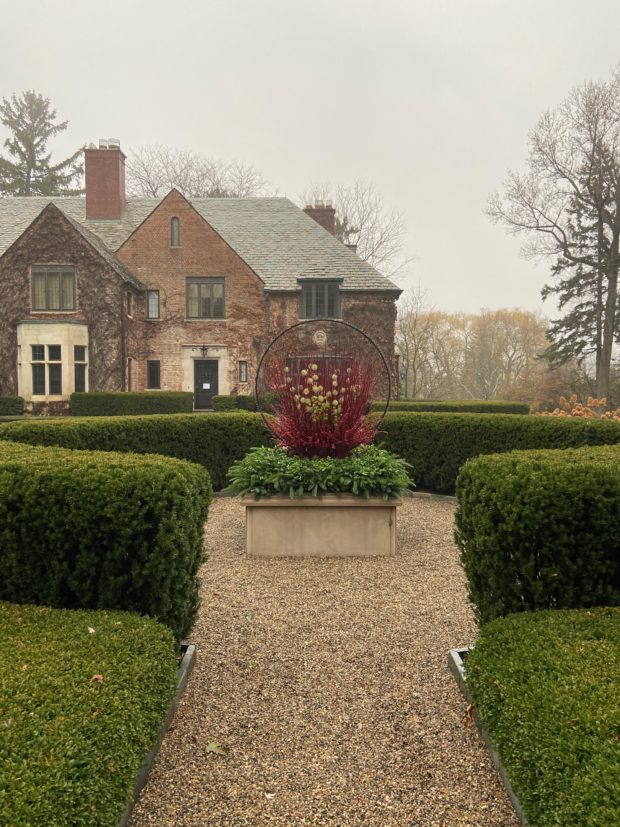 It is amazing how such a large arrangement, easily 6 feet square and as tall, does not look so big, once it is set in place. It just looks like it is the right size.
It is amazing how such a large arrangement, easily 6 feet square and as tall, does not look so big, once it is set in place. It just looks like it is the right size.
